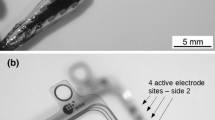Abstract
The effects of imbalanced biphasic stimulation were studied on cat skeletal muscle to determine if greater charge densities can be safely used than with balanced or monophasic stimulation. The results of the study indicate that imbalanced biphasic stimulation can be tolerated safely by tissue at or below a net dc current density of 35 μA/mm2 and not safely tolerated at or above a net dc current of 50 μA/mm2. Monophasic stimulation has been shown to be safe at or below net dc current levels of 10 μA/mm2 and in these studies we found it was not safe at or above net dc current levels of 20 μA/mm2. Stimuli were applied to muscles via coiled wire intramuscular electrodes using a regulated current source. Since the safe average current density was higher for imbalanced biphasic stimulation than for monophasic stimulation, this suggests that: (a) pH change is not the primary reaction causing tissue damage and (b) the damaging electrochemical process that takes place during a cathodic stimulation pulse can be reversed by an anodic pulse having substantially less charge than its companion cathodic pulse. We conclude that greater cathodic charge densities can be safely employed with imbalanced biphasic stimulation than with either monophasic stimulation or balanced charge biphasic stimulation.
Similar content being viewed by others
References
Beck, T.R.; Ruggeri, R.T.; Ballestrasse, C.L. Calculations of temperature rise produced in body tissue by a spherical electrode. Ann. Biomed. Eng. 13:177–194; 1985.
Box, G.E.P.; Hunter, W.G.; Hunter, J.S. Statistics for experimenters — an introduction to design, data analysis, and model building. New York: Wiley, 1978.
Brummer, S.B.; Robblee, L.S.; Hambrecht, F.T. Criteria for selecting electrodes for electrical stimulation: Theoretical and practical considerations. Ann. N.Y. Acad. Sci. 405:159–171; 1983.
Caldwell, C.W.; Reswick, J.B. A percutaneous wire electrode for chronic research use. IEEE Trans. Biomed. Eng. 22:429–432; 1975.
Ferguson, G.A. Statistical analysis in psychology & education. New York: McGraw-Hill, 1976: p. 295.
Jones, L.J.; Proskauer, C.C.; Paull, W.K.; Lepeschkin, E.; Jones, R.E. Ultrastructural injury to chick myocardial cells in vitro following “electric countershock”. Circ Res. 46:387–394; 1980.
Jones, J.L.; Jones, R.E. Decreased defibrillator-induced dysfunction with biphasic rectangular waveforms. Am. J. Phys. H792–H796; 1986.
Mchardy,; Geller, J.D.; Brummer, S.B. An approach to corrosion control during electrical stimulation. Ann. Biomed. Eng. 5:155–149; 1977.
Mortimer, J.T.; Kaufmann, D.; Roessmann, U. Intramuscular electrical stimulation: tissue damage. Ann. Biomed. Eng. 8:235–244; 1980.
Contract Proposal #NIH-NINCDS-87-01, Electrodes for neuromuscular stimulation. Applied Neural Control Lab., Case Western Reserve University, July 1, 1987.
Author information
Authors and Affiliations
Additional information
Supported by the Veterans Administration, Grant No. V541P-3141 and the National Institutes of Health-National Institute of Neurological and Communicative Disorders and Stroke, Neural Prosthesis Program, Contract No. NOI-NS-4-2362.
Rights and permissions
About this article
Cite this article
Scheiner, A., Mortimer, J.T. & Roessmann, U. Imbalanced biphasic electrical stimulation: Muscle tissue damage. Ann Biomed Eng 18, 407–425 (1990). https://doi.org/10.1007/BF02364157
Received:
Revised:
Issue Date:
DOI: https://doi.org/10.1007/BF02364157




